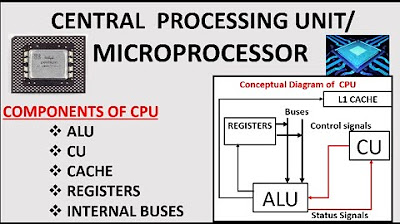AS & A Level Computer Science (9618) - Chapter 5: Core Concepts of Processor Functionality
Summary
TLDRThis lecture on processor fundamentals explores the essential components of a CPU, including the Arithmetic Logic Unit (ALU), control unit, and registers. It covers the Von Neumann architecture, emphasizing the significance of clock speed, core count, cache memory, and bus width in determining CPU performance. The fetch-decode-execute cycle illustrates how instructions are processed, while register transfer notation clarifies data movement within the CPU. Additionally, the lecture addresses how interrupts allow the system to manage multiple tasks efficiently, highlighting the balance between executing programs and responding to critical events.
Takeaways
- 🖥️ The CPU is the core component of a computer system, processing data from inputs and directing outputs.
- ⚙️ The Volumen architecture consists of a CPU, memory, and input/output devices, emphasizing direct memory access.
- 🔢 The ALU performs all arithmetic and logical operations within the CPU, crucial for program execution.
- 👨💼 The Control Unit manages data flow and ensures accurate instruction execution across the CPU and system.
- 📦 Registers serve as high-speed storage within the CPU, allowing quick access to frequently used data and instructions.
- 🔗 System buses (address, data, control) facilitate communication between the CPU, memory, and peripheral devices.
- ⏩ Factors influencing CPU performance include clock speed, number of cores, cache memory, and bus width.
- 🔌 Input devices communicate with the CPU through ports and device controllers, enabling data transfer.
- 🔄 The Fetch-Decode-Execute cycle is a fundamental process for executing instructions in a sequence.
- ⚠️ Interrupts allow the CPU to temporarily halt current operations to handle urgent tasks, enhancing system flexibility.
Q & A
What are the main components of a computer system as described in the video?
-The main components of a computer system include the central processing unit (CPU), memory, and input/output devices.
What is the central processing unit (CPU) and its role in a computer system?
-The CPU is the processor that processes data received from input devices and sends processed data to output devices. It is crucial for executing instructions and managing data flow within the system.
What are the five features of the Von Neumann architecture mentioned in the video?
-The five features include the presence of a CPU, direct access to memory, replaceable stored programs, sequential instruction execution, and the separation of data and instructions.
Can you explain the function of the arithmetic logic unit (ALU) within the CPU?
-The ALU performs arithmetic and logical operations required by active programs, handling calculations and logical decisions.
What is the purpose of the control unit in the CPU?
-The control unit manages data flow within the CPU and the overall computer system, directing other components and ensuring accurate execution of instructions.
How does the CPU utilize registers, and what types are discussed?
-Registers act as temporary storage within the CPU for quick access to data. The video mentions general-purpose registers, like the accumulator (ACC), and special-purpose registers for specific functions.
What are the three types of buses in a computer system, and what are their roles?
-The three types of buses are the address bus (transmits address information), data bus (transports data and is bidirectional), and control bus (sends control signals between components).
What factors can contribute to improving CPU performance?
-Factors include increasing clock speed, adding more CPU cores for concurrent processing, using cache memory for quicker data access, and optimizing bus width.
What is the fetch-decode-execute cycle in CPU operations?
-The fetch-decode-execute cycle is the process by which the CPU retrieves an instruction from memory, decodes it to understand its action, and then executes it sequentially.
How does the CPU handle interrupts during program execution?
-The CPU temporarily halts the current program to address an interrupt by saving the current state, executing the interrupt service routine, and then restoring the original program state.
Outlines

This section is available to paid users only. Please upgrade to access this part.
Upgrade NowMindmap

This section is available to paid users only. Please upgrade to access this part.
Upgrade NowKeywords

This section is available to paid users only. Please upgrade to access this part.
Upgrade NowHighlights

This section is available to paid users only. Please upgrade to access this part.
Upgrade NowTranscripts

This section is available to paid users only. Please upgrade to access this part.
Upgrade Now5.0 / 5 (0 votes)





